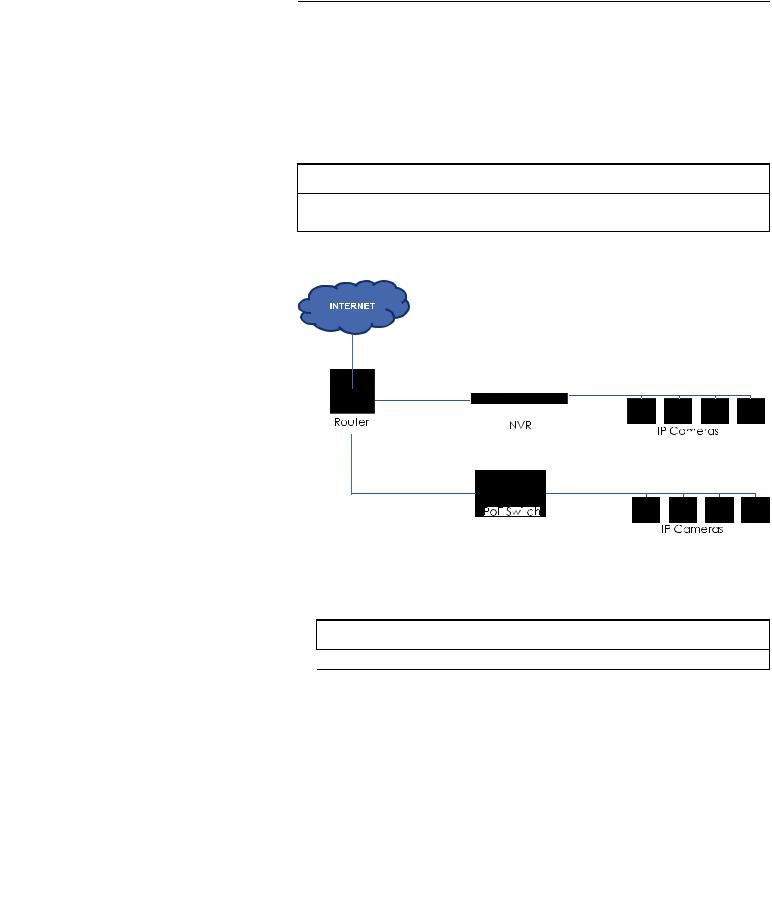Flir DNR71612, DNR71616, DNR7166, DNR7168, DNR73212 User Manual
...
Instruction Manual
DNR700 SERIES

Instruction Manual
DNR700 SERIES
#LX400082; r. 1.0/38226/38226; en-US |
iii |

Thank you for purchasing this product. FLIR Systems, Inc. is committed to providing our customers with a high quality, reliable security solution.
This manual refers to the following models:
DNR708 (8-channel)
DNR716 (16-channel)
DNR732 (32-channel)
For the latest online manual, downloads and product updates, and to learn about our complete line of accessory products, please visit our website at:
www.flir.com/security/pro
WARNING
RISK OF ELECTRIC SHOCK
DO NOT OPEN
WARNING: TO REDUCE THE RISK OF ELECTRIC SHOCK DO NOT REMOVE
COVER. NO USER SERVICEABLE PARTS INSIDE.
REFER SERVICING TO QUALIFIED SERVICE PERSONNEL.
The lightning flash with arrowhead symbol, within an equilateral triangle, is intended to alert the user to the presence of uninsulated "dangerous voltage" within the product’s enclosure that may be of sufficient magnitude to constitute a risk of electric shock.
The exclamation point within an equilateral triangle is intended to alert the user to the presence of important operating and maintenance (servicing) instructions in the literature accompanying the appliance.
WARNING: TO PREVENT FIRE OR SHOCK HAZARD, DO NOT EXPOSE THIS UNIT TO RAIN OR MOISTURE.
CAUTION: TO PREVENT ELECTRIC SHOCK, MATCH WIDE BLADE OF THE PLUG TO THE WIDE SLOT AND FULLY INSERT.
#LX400082; r. 1.0/38226/38226; en-US |
iv |

Table of contents
1 |
Important Safeguards .......................................................................... |
1 |
||
|
1.1 |
General Precautions.................................................................... |
1 |
|
|
1.2 |
Installation................................................................................. |
1 |
|
|
1.3 |
Service..................................................................................... |
|
3 |
|
1.4 |
Use.......................................................................................... |
|
3 |
2 |
Getting Started (DNR700 Series) ........................................................... |
4 |
||
3 |
DNR700 Series Front Panel................................................................... |
5 |
||
4 |
Rear Panel (DNR700 Series) ................................................................. |
7 |
||
5 |
Basic Setup (DNR700 Series)................................................................ |
8 |
||
|
5.1 |
Step 1: Connect the IP Cameras .................................................... |
8 |
|
|
5.2 |
Step 2: Connect the Mouse........................................................... |
8 |
|
|
5.3 |
Step 3: Connect the Ethernet Cable ................................................ |
8 |
|
|
5.4 |
Step 4: Connect the Monitor.......................................................... |
8 |
|
|
5.5 |
Step 5: Connect the Power Cable to Power the NVR........................... |
9 |
|
|
5.6 |
Step 6: Upgrade Firmware to Latest Version (if Available) .................... |
9 |
|
|
5.7 |
Step 7: Verify Camera Image ......................................................... |
9 |
|
|
5.8 |
Step 8: Set the Time .................................................................. |
10 |
|
|
5.9 |
Default System Password & Port Numbers ..................................... |
10 |
|
|
5.10 |
5.9.1 |
FLIR Cloud™ ................................................................ |
10 |
|
Quick Access to System Information ............................................. |
10 |
||
|
5.11 |
Connecting Cameras to the Local Area Network (LAN) ..................... |
12 |
|
6 |
Mouse Control |
.................................................................................. |
15 |
|
7 |
Remote Control ................................................................................. |
16 |
||
|
7.1 |
Setting the Remote Control Address ............................................. |
17 |
|
8 |
Using the System .............................................................................. |
18 |
||
|
8.1 |
On-Screen Display .................................................................... |
18 |
|
|
8.2 |
Using the Quick Menu................................................................ |
19 |
|
|
8.3 |
Adjusting Camera Image Settings................................................. |
19 |
|
|
8.4 |
Using the Navigation Bar ............................................................ |
21 |
|
|
8.5 |
Using the Camera Toolbar .......................................................... |
21 |
|
|
|
8.5.1 |
Using Quick Playback ..................................................... |
22 |
|
|
8.5.2 Using Digital Zoom in Live Display ..................................... |
22 |
|
|
8.6 |
8.5.3 |
Using Real-time Backup .................................................. |
22 |
|
Using the Virtual Keyboard.......................................................... |
23 |
||
|
8.7 |
Adjusting Camera Zoom & Focus ................................................. |
23 |
|
9 |
Setting The Time ............................................................................... |
24 |
||
10 |
Recording......................................................................................... |
|
25 |
|
|
10.1 |
Video Recording Types .............................................................. |
25 |
|
|
10.2 |
Main Stream and Sub Stream...................................................... |
25 |
|
|
10.3 |
Setting up Scheduled or Manual Recording .................................... |
25 |
|
|
10.4 |
Configuring Hard Drive Overwrite ................................................. |
26 |
|
11 |
Search (Playback) ............................................................................. |
28 |
||
|
11.1 |
Playing Back Video from the Hard Drive......................................... |
28 |
|
|
11.2 |
Playback Controls ..................................................................... |
29 |
|
|
11.3 |
Playing Back from a USB Drive .................................................... |
29 |
|
|
11.4 |
Using Smart Search .................................................................. |
30 |
|
12 |
Backup............................................................................................. |
|
32 |
|
|
12.1 |
Formatting the USB Thumb Drive ................................................. |
32 |
|
|
12.2 |
Backing up Video...................................................................... |
33 |
|
#LX400082; r. 1.0/38226/38226; en-US |
v |

Table of contents
|
12.3 |
Using Video Clip Backup ............................................................ |
33 |
|
|
12.4 |
Viewing Backup Files................................................................. |
34 |
|
|
|
12.4.1 Viewing Backup Files on PC ............................................. |
34 |
|
|
|
12.4.2 Viewing Backup Files on Mac ........................................... |
37 |
|
13 |
Managing Passwords and User Accounts............................................. |
40 |
||
|
13.1 |
Changing Passwords................................................................. |
40 |
|
|
13.2 |
Adding Users ........................................................................... |
41 |
|
|
13.3 |
Modifying Users ....................................................................... |
41 |
|
|
13.4 |
Deleting Users ......................................................................... |
42 |
|
|
13.5 |
Account Groups ....................................................................... |
42 |
|
|
13.6 |
Adding Groups ......................................................................... |
42 |
|
|
13.7 |
Modifying Groups ..................................................................... |
43 |
|
|
13.8 |
Deleting Groups ....................................................................... |
43 |
|
14 |
Using the Main Menu ......................................................................... |
44 |
||
|
14.1 |
Camera |
Remote..................................................................................Device |
44 |
|
|
14.1.1 |
44 |
|
|
|
14.1.2 |
Viewing Camera Status ................................................... |
45 |
|
|
14.1.3 Viewing Camera Firmware Versions ................................... |
45 |
|
|
|
14.1.4 |
Upgrading Camera Firmware ............................................ |
45 |
|
|
14.1.5 |
Recording..................................................................... |
46 |
|
|
14.1.6 |
Configuring Recording Quality .......................................... |
46 |
|
|
14.1.7 |
Configuring Audio Recording ............................................ |
47 |
|
|
14.1.8 Configuring Snapshot Recording Settings............................ |
48 |
|
|
14.2 |
14.1.9 Creating Custom Channel Names...................................... |
49 |
|
|
Info ........................................................................................ |
HDD Info |
50 |
|
|
|
14.2.1 |
50 |
|
|
|
14.2.2 |
Record Info................................................................... |
50 |
|
|
14.2.3 |
Version ........................................................................ |
51 |
|
|
14.2.4 |
Event Info ..................................................................... |
51 |
|
|
14.2.5 |
Online Users ................................................................. |
52 |
|
|
14.2.6 |
Load............................................................................ |
52 |
|
|
14.2.7 |
Test............................................................................. |
53 |
|
|
14.2.8 |
BPS ............................................................................ |
53 |
|
14.3 |
14.2.9 |
Log ............................................................................. |
53 |
|
Setting.................................................................................... |
Network |
55 |
|
|
|
14.3.1 |
55 |
|
|
|
14.3.2 Selecting DHCP or Static IP Address (TCP/IP) ...................... |
55 |
|
|
|
14.3.3 Configuring System Ports (Connection)............................... |
56 |
|
|
|
14.3.4 |
Configuring DDNS Settings .............................................. |
57 |
|
|
14.3.5 |
Configuring Email Alerts .................................................. |
57 |
|
|
14.3.6 Configuring Switch Settings (Advanced).............................. |
58 |
|
|
|
14.3.7 |
Event........................................................................... |
59 |
|
|
14.3.8 |
Configuring Motion Detection............................................ |
59 |
|
|
14.3.9 Configuring Video Loss Settings ........................................ |
61 |
|
|
|
14.3.10 Configuring Alarm Input Devices........................................ |
62 |
|
|
|
14.3.11 Controlling Alarm Output Devices ...................................... |
63 |
|
|
|
14.3.12 Configuring Hard Drive Warnings....................................... |
64 |
|
|
|
14.3.13 Configuring Network Warnings .......................................... |
65 |
|
|
|
14.3.14 Storage........................................................................ |
65 |
|
|
|
14.3.15 Configuring the Video Recording Schedule .......................... |
66 |
|
#LX400082; r. 1.0/38226/38226; en-US |
vi |

Table of contents
|
|
14.3.16 Configuring Pre-Recording ............................................... |
66 |
|
|
|
14.3.17 Configuring the Snapshot Schedule ................................... |
67 |
|
|
|
14.3.18 Configuring Holidays....................................................... |
68 |
|
|
|
14.3.19 Formatting the Hard Drive ................................................ |
69 |
|
|
|
14.3.20 Configuring Hard Drive Type ............................................. |
70 |
|
|
|
14.3.21 Setting up Hard Drive Mirroring (Advanced) ......................... |
70 |
|
|
|
14.3.22 Configuring Hard Drive Groups (Advanced) ......................... |
71 |
|
|
|
14.3.23 Configuring General System Settings ................................. |
73 |
|
|
|
14.3.24 Setting the Monitor Resolution (Display) .............................. |
74 |
|
|
|
14.3.25 Saving Your System Configuration to a USB Thumb |
75 |
|
|
|
|
Drive ........................................................................... |
|
|
|
14.3.26 Setting the System to Factory Defaults................................ |
76 |
|
|
14.4 |
14.3.27 Upgrading Firmware from USB.......................................... |
77 |
|
|
Shutdown................................................................................ |
78 |
||
15 |
Connecting to Your System Over the Internet on PC or Mac .................... |
79 |
||
|
15.1 |
System Requirements................................................................ |
79 |
|
|
15.2 |
Step 1 of 3: Connect your System to Your Router ............................. |
79 |
|
|
15.3 |
Step 2 of 3: Obtain the system’s Device ID...................................... |
80 |
|
|
15.4 |
Step 3 of 3: Connect to the System Over the Internet ........................ |
80 |
|
16 |
Using FLIR Cloud™ Client for PC or Mac .............................................. |
84 |
||
|
16.1 |
Home Page ............................................................................. |
84 |
|
|
16.2 |
Live View ................................................................................ |
84 |
|
|
|
16.2.1 |
Live View Controls.......................................................... |
85 |
|
16.3 |
16.2.2 Opening Live View in Multiple Monitors ............................... |
86 |
|
|
Controlling PTZ Cameras ........................................................... |
87 |
||
|
|
16.3.1 |
PTZ Presets.................................................................. |
88 |
|
|
16.3.2 |
PTZ Tours..................................................................... |
89 |
|
|
16.3.3 |
PTZ Pattern .................................................................. |
90 |
|
|
16.3.4 |
PTZ Scan ..................................................................... |
91 |
|
16.4 |
16.3.5 |
PTZ Pan....................................................................... |
91 |
|
Playback................................................................................. |
91 |
||
|
16.5 |
Playback Controls ..................................................................... |
93 |
|
|
16.6 |
Downloading Video to your Computer Hard Drive............................. |
94 |
|
|
16.7 |
Alarm ..................................................................................... |
|
95 |
|
16.8 |
Log........................................................................................ |
|
96 |
|
16.9 |
E-map .................................................................................... |
|
97 |
|
16.10 |
Devices |
.................................................................................. |
99 |
|
16.11 |
Device Config ........................................................................ |
100 |
|
|
16.12 |
Alarm CFG ............................................................................ |
100 |
|
|
16.13 |
Tour & Task ........................................................................... |
103 |
|
|
16.14 |
Account ................................................................................ |
104 |
|
|
|
16.14.1 Managing User Accounts ............................................... |
104 |
|
|
16.15 |
16.14.2 Managing Roles........................................................... |
106 |
|
|
General |
................................................................................ |
107 |
|
|
|
16.15.1 Basic......................................................................... |
107 |
|
|
|
16.15.2 File ........................................................................... |
107 |
|
|
|
16.15.3 Alarm Prompt .............................................................. |
108 |
|
|
|
16.15.4 Version ...................................................................... |
109 |
|
17 |
Connecting to your System Using Smartphone or Tablet Apps.............. |
110 |
||
|
17.1 |
iPhone.................................................................................. |
|
110 |
#LX400082; r. 1.0/38226/38226; en-US |
vii |

Table of contents
|
|
17.1.1 |
Prerequisites ............................................................... |
110 |
|
|
17.1.2 Connecting to your System on iPhone............................... |
110 |
|
|
|
17.1.3 |
Live View Interface ....................................................... |
111 |
|
|
17.1.4 |
Controlling PTZ Cameras............................................... |
112 |
|
|
17.1.5 Viewing Snapshots and Videos with Local Files .................. |
113 |
|
|
|
17.1.6 Using Playback Mode on iPhone ..................................... |
114 |
|
|
|
17.1.7 |
Enabling Push Notifications ............................................ |
115 |
|
|
17.1.8 Using the Event List ...................................................... |
117 |
|
|
|
17.1.9 |
Using Favorites............................................................ |
118 |
|
|
17.1.10 Using the E-Map .......................................................... |
119 |
|
|
|
17.1.11 Device Manager........................................................... |
121 |
|
|
|
17.1.12 Adding Devices Using an IP or DDNS Address |
122 |
|
|
17.2 |
iPad |
(Advanced) ................................................................. |
|
|
Prerequisites |
124 |
||
|
|
17.2.1 |
124 |
|
|
|
17.2.2 Connecting to your system on an iPad .............................. |
124 |
|
|
|
17.2.3 |
Live View Interface ....................................................... |
125 |
|
|
17.2.4 |
Controlling PTZ Cameras............................................... |
126 |
|
|
17.2.5 Using Playback Mode on iPad......................................... |
127 |
|
|
|
17.2.6 Using Local File to View Manual Recordings ...................... |
129 |
|
|
|
17.2.7 |
Enabling Push Notifications ............................................ |
130 |
|
|
17.2.8 Using the Event List ...................................................... |
132 |
|
|
|
17.2.9 |
Using Favorites............................................................ |
133 |
|
|
17.2.10 Using the E-Map .......................................................... |
134 |
|
|
|
17.2.11 Using the Device Manager ............................................. |
136 |
|
|
|
17.2.12 Adding Devices Using an IP or DDNS Address |
136 |
|
|
17.3 |
Android |
(Advanced) ................................................................. |
|
|
Prerequisites................................................................................ |
139 |
||
|
|
17.3.1 |
139 |
|
|
|
17.3.2 Connecting to your System on Android ............................. |
139 |
|
|
|
17.3.3 |
Live View Interface ....................................................... |
140 |
|
|
17.3.4 |
Controlling PTZ Cameras............................................... |
141 |
|
|
17.3.5 Viewing Snapshots and Videos with Local Files .................. |
142 |
|
|
|
17.3.6 Using Playback Mode on Android .................................... |
142 |
|
|
|
17.3.7 |
Enabling Push Notifications ............................................ |
144 |
|
|
17.3.8 Using the Event List ...................................................... |
145 |
|
|
|
17.3.9 |
Using Favorites............................................................ |
145 |
|
|
17.3.10 Using the E-Map .......................................................... |
147 |
|
|
|
17.3.11 Device Manager........................................................... |
148 |
|
|
|
17.3.12 Adding Devices Using an IP or DDNS Address |
149 |
|
|
|
|
(Advanced) ................................................................. |
|
18 |
Remote Viewing On Internet Explorer ................................................ |
151 |
||
|
18.1 |
Prerequisites ......................................................................... |
151 |
|
|
|
18.1.1 IE Live Display Overview................................................ |
152 |
|
|
|
18.1.2 Using Search Mode in IE (Playback)................................. |
153 |
|
19 |
RTSP Streaming (Advanced)............................................................. |
155 |
||
20 |
DDNS Setup (Advanced) .................................................................. |
157 |
||
|
20.1 Accessing your System within a Local Network (LAN) ..................... |
157 |
||
|
|
20.1.1 Step 1 of 3: Connect your System to Your Router ................ |
157 |
|
|
|
20.1.2 |
Step 2 of 3: Obtain the System’s Local IP Address ............... |
158 |
#LX400082; r. 1.0/38226/38226; en-US |
viii |

Table of contents
20.1.3 Step 3 of 3: Connect to the System’s Local IP |
|
Address ..................................................................... |
158 |
20.2DDNS Setup—Access your System Remotely over the
|
|
Internet................................................................................. |
|
160 |
|
|
20.2.1 Step 1 of 4: Port Forwarding ........................................... |
161 |
|
|
|
20.2.2 Step 2 of 4: Create a DDNS Account ................................ |
161 |
|
|
|
20.2.3 Step 3 of 4: Enable DDNS on the System .......................... |
162 |
|
|
|
20.2.4 Step 4 of 4: Connect to the System’s DDNS Address ........... |
163 |
|
21 |
Connecting a PTZ Camera (DNR700 Series)........................................ |
167 |
||
|
21.1 |
Controlling a PTZ Camera (Local NVR) ....................................... |
169 |
|
|
21.2 |
Advanced PTZ Controls ........................................................... |
169 |
|
|
|
21.2.1 |
Presets ...................................................................... |
170 |
|
|
21.2.2 |
Tours ......................................................................... |
171 |
|
|
21.2.3 |
Pattern....................................................................... |
171 |
|
|
21.2.4 |
Auto Scan .................................................................. |
172 |
22 |
DNR700 Series Hard Drive Installation ............................................... |
173 |
||
|
22.1 |
Installing a Hard Drive.............................................................. |
173 |
|
|
22.2 |
Removing the Hard Drive.......................................................... |
174 |
|
|
22.3 |
Formatting Hard Drives ............................................................ |
175 |
|
23 |
Troubleshooting .............................................................................. |
177 |
||
24 |
DNR700 Series System Specifications ............................................... |
179 |
||
|
24.1 |
System ................................................................................. |
|
179 |
|
24.2 |
Inputs/Outputs ....................................................................... |
179 |
|
|
24.3 |
Display ................................................................................. |
|
179 |
|
24.4 |
Recording ............................................................................. |
179 |
|
|
24.5 |
Playback and Backup .............................................................. |
180 |
|
|
24.6 |
Storage & Archive ................................................................... |
180 |
|
|
24.7 |
Connectivity........................................................................... |
180 |
|
|
24.8 |
General |
................................................................................ |
181 |
|
24.9 |
Recording Resolution (Pixels) & Speed (FPS — Frames per |
181 |
|
|
|
second) ................................................................................ |
||
25 |
Notices........................................................................................... |
|
182 |
|
|
25.1 |
FCC Class A Notice ................................................................ |
182 |
|
#LX400082; r. 1.0/38226/38226; en-US |
ix |

1 |
Important Safeguards |
In addition to the careful attention devoted to quality standards in the manufacturing process of your product, safety is a major factor in the design of every instrument. However, safety is your responsibility too. This sheet lists important information that will help to ensure your enjoyment and proper use of the product and accessory equipment. Please read them carefully before operating and using your product.
1.1 General Precautions
1.All warnings and instructions in this manual should be followed.
2.Remove the plug from the outlet before cleaning. Do not use liquid aerosol detergents. Use a water-dampened cloth for cleaning.
3.Do not use this product in humid or wet places.
4.Keep enough space around the product for ventilation. Slots and openings in the storage cabinet should not be blocked.
5.It is highly recommended to connect the product to a surge protector to protect from damage caused by electrical surges. It is also recommended to connect the product to an uninterruptible power supply (UPS), which has an internal battery that will keep the product running in the event of a power outage.
CAUTION
Maintain electrical safety. Power line operated equipment or accessories connected to this product should bear the UL listing mark or CSA certification mark on the accessory itself and should not be modified so as to defeat the safety features. This will help avoid any potential hazard from electrical shock or fire. If in doubt, contact qualified service personnel.
1.2 Installation
1.Read and Follow Instructions - All the safety and operating instructions should be read before the product is operated. Follow all operating instructions.
2.Retain Instructions - The safety and operating instructions should be retained for future reference.
3.Heed Warnings - Comply with all warnings on the product and in the operating instructions.
4.Polarization - Do not defeat the safety purpose of the polarized or grounding-type plug.
A polarized plug has two blades with one wider than the other.
A grounding type plug has two blades and a third grounding prong.
The wide blade or the third prong are provided for your safety.
If the provided plug does not fit into your outlet, consult an electrician for replacement of the obsolete outlet.
#LX400082; r. 1.0/38226/38226; en-US |
1 |

1 |
Important Safeguards |
5.Power Sources - This product should be operated only from the type of power source indicated on the marking label. If you are not sure of the type of power supplied to your location, consult your video dealer or local power company. For products intended to operate from battery power, or other sources, refer to the operating instructions.
6.Overloading - Do not overload wall outlets or extension cords as this can result in the risk of fire or electric shock. Overloaded AC outlets, extension cords, frayed power cords, damaged or cracked wire insulation, and broken plugs are dangerous. They may result in a shock or fire hazard. Periodically examine the cord, and if its appearance indicates damage or deteriorated insulation, have it replaced by your service technician.
7.Power-Cord Protection - Power supply cords should be routed so that they are not likely to be walked on or pinched by items placed upon or against them. Pay particular attention to cords at plugs, convenience receptacles, and the point where they exit from the product.
8.Surge Protectors - It is highly recommended that the product be connected to a surge protector. Doing so will protect the product from damage caused by power surges. Surge protectors should bear the UL listing mark or CSA certification mark.
9.Uninterruptible Power Supplies (UPS) - Because this product is designed for continuous, 24/7 operation, it is recommended that you connect the product to an uninterruptible power supply. An uninterruptible power supply has an internal battery that will keep the product running in the event of a power outage. Uninterruptible power supplies should bear the UL listing mark or CSA certification mark.
10.Ventilation - Slots and openings in the case are provided for ventilation to ensure reliable operation of the product and to protect it from overheating. These openings must not be blocked or covered. The openings should never be blocked by placing the product on a bed, sofa, rug, or other similar surface. This product should never be placed near or over a radiator or heat register. This product should not be placed in a built-in installation such as a bookcase or rack unless proper ventilation is provided and the product manufacturer’s instructions have been followed.
11.Attachments - Do not use attachments unless recommended by the product manufacturer as they may cause a hazard.
12.Water and Moisture - Do not use this product near water — for example, near a bath tub, wash bowl, kitchen sink or laundry tub, in a wet basement, near a swimming pool and the like.
13.Heat - The product should be situated away from heat sources such as radiators, heat registers, stoves, or other products (including amplifiers) that produce heat.
14.Accessories - Do not place this product on an unstable cart, stand, tripod, or table. The product may fall, causing serious damage to the product. Use this product only with a cart, stand, tripod, bracket, or table recommended by the manufacturer or sold with the product. Any mounting of the product should follow the manufacturer’s instructions and use a mounting accessory recommended by the manufacturer.
15.Camera Extension Cables – Check the rating of your extension cable(s) to verify compliance with your local authority regulations prior to installation.
16.Mounting - The cameras provided with this system should be mounted only as instructed in this guide or the instructions that came with your cameras, using the provided mounting brackets.
#LX400082; r. 1.0/38226/38226; en-US |
2 |

1 |
Important Safeguards |
17.Camera Installation - Cameras are not intended for submersion in water. Not all cameras can be installed outdoors. Check your camera environmental rating to confirm if they can be installed outdoors. When installing cameras outdoors, installation in a sheltered area is required.
1.3 Service
1.Servicing - Do not attempt to service this product yourself, as opening or removing covers may expose you to dangerous voltage or other hazards. Refer all servicing to qualified service personnel.
2.Conditions Requiring Service - Unplug this product from the wall outlet and refer servicing to qualified service personnel under the following conditions:
•When the power supply cord or plug is damaged.
•If liquid has been spilled or objects have fallen into the product.
•If the product has been exposed to rain or water.
•If the product has been dropped or the cabinet has been damaged
•If the product does not operate normally by following the operating instructions. Adjust only those controls that are covered by the operating instructions. Improper adjustment of other controls may result in damage and will often require extensive work by a qualified technician to restore the product to its normal operation.
•When the product exhibits a distinct change in performance. This indicates a need for service.
3.Replacement Parts - When replacement parts are required, have the service technician verify that the replacements used have the same safety characteristics as the original parts. Use of replacements specified by the product manufacturer can prevent fire, electric shock, or other hazards.
4.Safety Check - Upon completion of any service or repairs to this product, ask the service technician to perform safety checks recommended by the manufacturer to determine that the product is in safe operating condition.
1.4Use
1.Cleaning - Unplug the product from the wall outlet before cleaning. Do not use liquid cleaners or aerosol cleaners. Use a damp cloth for cleaning.
2.Product and Cart Combination - When product is installed on a cart, product and cart combination should be moved with care. Quick stops, excessive force, and uneven surfaces may cause the product and cart combination to overturn.
3.Object and Liquid Entry - Never push objects of any kind into this product through openings as they may touch dangerous voltage points or “short-out” parts that could result in a fire or electric shock. Never spill liquid of any kind on the product.
4.Lightning - For added protection of this product during a lightning storm, or when it is left unattended and unused for long periods of time, unplug it from the wall outlet and disconnect the antenna or cable system. This will prevent damage to the product due to lightning and power line surges.
#LX400082; r. 1.0/38226/38226; en-US |
3 |

2 |
Getting Started (DNR700 Series) |
The system comes with the following components:
NVR (Network Video Recorder) |
AC Power Cable |
Remote Control |
|
(may not be exactly as shown) |
|||
|
|
USB Mouse |
Ethernet Cable |
Quick Start Guides |
Hard drive size, number of channels, and camera configuration may vary by model. Please refer to your package for specific details. Check your package to confirm that you have received the complete system, including all components shown above.
#LX400082; r. 1.0/38226/38226; en-US |
4 |

3 |
DNR700 Series Front Panel |
1.USB Port: Connect a USB mouse (included) or connect a USB flash drive (not included) for data backup or firmware upgrades.
2.Playback Controls:
• Pause/Play: In live view, press to enter playback mode. Press to play/pause playback.
Pause/Play: In live view, press to enter playback mode. Press to play/pause playback.
• Fast: Press to increase playback speed.
Fast: Press to increase playback speed.
• Next: Press to skip to next video.
Next: Press to skip to next video.
• Reverse: Press to reverse playback/pause playback.
Reverse: Press to reverse playback/pause playback.
• Slow: Press for slow playback.
Slow: Press for slow playback.
• Previous: Press to skip to previous video.
Previous: Press to skip to previous video.
3.Function Buttons:
•REC: Press to open manual recording controls.
•FN: Performs special functions in some menus.
•SHIFT: During text input, press to switch input types.
•ESC: In menus, press to go back / exit menus. In playback, press to return to live view.
4.Directional Buttons:
•ENTER: From live view, press once to open the System Information screen; press twice to open the Main Menu. In menus, press to confirm menu options.
•Directional Buttons: Press to move cursor in menus. In live view, press up to change split screen layout; press left / right to select channels when single-channel mode is selected.
5.Power Button: Press and hold to power off the system. Press to power the system back on.
#LX400082; r. 1.0/38226/38226; en-US |
5 |

3 |
DNR700 Series Front Panel |
6.IR Receiver and LED Indicators: IR receiver for the remote control. Keep the IR receiver clear from obstructions.
LED Indicators:
•POWER: Glows to indicate the system is on.
•HDD: Glows to indicate hard drive is in normal state. Turns off when there is a hard drive error.
•NET: Glows when network is in normal state. Turns off for network error.
•Channel Indicators: Flashes slow when channel 1~16 are recording. On 32–chan- nel models, flashes fast when channels 17~32 are recording. For example, if the light for channel 1 is flashing fast, it indicates channel 17 is recording. Glows solid to indicate both corresponding channels (e.g. channel 1 and channel 17 are recording).
7.IR: Not supported.
#LX400082; r. 1.0/38226/38226; en-US |
6 |

4 |
Rear Panel (DNR700 Series) |
1.Power Input: Connect the included AC power cable.
2.ON / OFF Switch: Turns the NVR on or off.
3.PoE Ports: Connect IP cameras. Integrated PoE (Power Over Ethernet) ports provide power to cameras and video connection to NVR.
4.LAN: Connect a CAT 5 RJ45 Ethernet cable for local and remote connectivity.
5.VGA: Connect a VGA monitor (not included) to view the system interface.
6.MIC IN/OUT: RCA input and output for 2–way audio.
NOTE
Audio-enabled IP cameras (not included) are required to use audio recording. You cannot record audio from the input (e.g. microphone) connected to the MIC IN port.
7.HDMI: Connect to an HDMI monitor or TV (not included) to view the system interface.
8.RS232: Service only; not supported.
9.USB port(s): Connect a USB mouse (included) or USB thumb drive (not included) for data backup or firmware updates.
10.Alarm Block: Connect alarm/sensor devices (not included).
#LX400082; r. 1.0/38226/38226; en-US |
7 |

5 |
Basic Setup (DNR700 Series) |
5.1 Step 1: Connect the IP Cameras
Option 1: Direct Connection to NVR
•Connect cameras to the PoE Ports on the rear panel of the NVR using Cat5e or higher grade Ethernet cable. The cameras will appear on the NVR without any additional configuration when the system starts up.
Connect IP cameras directly to PoE ports.
Option 2: Connect Cameras to Local Network
You can also connect your IP cameras to your local network for flexible installations. For details, see 5.11 Connecting Cameras to the Local Area Network (LAN), page 12.
5.2 Step 2: Connect the Mouse
• Connect a USB mouse (included) to one of the USB ports.
5.3 Step 3: Connect the Ethernet Cable
•Connect an Ethernet cable (included) to the LAN port on the rear panel of the system. Connect the other end of the Ethernet cable to a router on your network.
5.4 Step 4: Connect the Monitor
•Connect the included HDMI cable from the HDMI port to the TV or monitor (recommended).
OR
#LX400082; r. 1.0/38226/38226; en-US |
8 |

5 |
Basic Setup (DNR700 Series) |
• Connect a VGA cable (not included) from the VGA port to the monitor.
1.VGA port.
2.HDMI port.
5.5Step 5: Connect the Power Cable to Power the NVR
•Connect the included AC power cable to the NVR and connect the other end to a power outlet or surge protector. Then turn the power switch to l to power on the NVR.
At startup, the system performs a basic system check and runs an initial loading sequence.
After a few moments, the system loads a live display view.
5.6 Step 6: Upgrade Firmware to Latest Version (if Available)
If a firmware upgrade is available, you will be asked to install it once the system starts up. It is required to upgrade your system firmware and client software or mobile apps to the latest version to enable remote connection to the system.
If a firmware upgrade is available:
1.After startup, a notification will appear asking you to upgrade the firmware. Click OK to upgrade.
2.Enter the system user name (default: admin) and password (default: 000000) and click OK. Wait for the firmware update to complete. The system will restart once the firmware has been upgraded.
WARNING
DO NOT POWER OFF THE SYSTEM OR DISCONNECT THE POWER CABLE DURING FIRM-
WARE INSTALLATION
5.7 Step 7: Verify Camera Image
•Power on the cameras, and then verify the camera video quality before mounting the cameras to a permanent location.
•Mount the cameras under a sheltered location. Always verify the outdoor rating of your camera before installing it in a permanent location.
#LX400082; r. 1.0/38226/38226; en-US |
9 |

5 |
Basic Setup (DNR700 Series) |
5.8 Step 8: Set the Time
•Set the system time and date for accurate video time stamps. Videos with inaccurate times may not be valid as surveillance evidence.
•For details on setting the system time, see 9 Setting The Time, page 24.
5.9 Default System Password & Port Numbers
CAUTION
By default, the system user name is admin and the password is 000000. It is essential that you create your own password. For details, see 13 Managing Passwords and User Accounts, page 40.
The system requires a user name and password to log in to the system remotely using a computer or mobile device. After logging on remotely the first time, you will be asked to create a custom password for the system.
Local system and remote connectivity (LAN & Internet) user name and password:
•Username: admin
•Password: 000000
Default ports for DDNS remote access:
•Port 80 (HTTP port)
•Port 35000 (Client port)
5.9.1FLIR Cloud™
This system features the exclusive FLIR Cloud™. This is a cloud service that allows you to connect to your system over the Internet via a secure handshake with our servers. This means you can easily connect to your system without requiring any network configuration.
For details on setting up your system to connect to the Internet using FLIR
Cloud™:
•See 15 Connecting to Your System Over the Internet on PC or Mac, page 79.
OR
•See 17 Connecting to your System Using Smartphone or Tablet Apps, page 110.
Connectivity using FLIR’s free DDNS service is also available, but requires the ports listed above to be port forwarded on your router.
5.10 Quick Access to System Information
To quickly open a window that displays vital system information:
•Right-click to open the Quick Menu and click Info. Enter the system user name (default: admin) and password (default: 000000).
OR
•Press the ENTER button on the front panel.
OR
•Press the ENTER button on the remote control.
#LX400082; r. 1.0/38226/38226; en-US |
10 |

5 |
Basic Setup (DNR700 Series) |
NOTE
The QR code shown in the System Info screen can be scanned during mobile setup to enter the system’s
Device ID.
#LX400082; r. 1.0/38226/38226; en-US |
11 |

5 |
Basic Setup (DNR700 Series) |
5.11 Connecting Cameras to the Local Area Network (LAN)
For flexibility, you may also connect IP cameras to the same Local Area Network (LAN) as the NVR. This is accomplished by connecting the cameras to the same router as the NVR.
For these installations, an external PoE switch (sold separately) or power adapter (sold separately) must be used to provide power to each IP camera. You also must add the cameras on the NVR before they will show a picture on the monitor or be recorded by the NVR.
Follow the steps below to connect the cameras to the NVR over the LAN.
NOTE
•For a list of 3rd party IP cameras supported, please visit www.flir.com/security/support.
•Camera and NVR images in this section are used for illustration only.
Step 1 of 2 — Option A: Connecting cameras to your local network using a PoE switch:
1.Connect an Ethernet cable from the LAN port on an external PoE switch (sold separately on www.flir.com/security/pro) to your router using a CAT5e or higher Ethernet cable. Connect the power cable to the PoE swtich and to a power outlet or surge protector.
NOTE
 Terminology may vary depending on the model of PoE switch you have.
Terminology may vary depending on the model of PoE switch you have.
2.Connect the IP cameras to the PoE switch using the Ethernet extension cables. The PoE switch will provide power and video transmission the same way as your NVR.
#LX400082; r. 1.0/38226/38226; en-US |
12 |

5 |
Basic Setup (DNR700 Series) |
Step 1 of 2 — Option B: Connecting cameras to your local network using power adapters:
1.Connect each camera to a compatible power adapter (visit www.flir.com/security/pro for compatible power adapters for your cameras).
2.Connect the camera to your router using a CAT5e or higher Ethernet cable.
Step 2 of 2: Add the cameras to your NVR:
1.Right-click and select Device Search .
2.Log in using the admin account (default User Name: admin; default Password:
000000).
3.Click Device Search. The system searches the network for compatible cameras.
4. Check the camera(s) you would like to add.
#LX400082; r. 1.0/38226/38226; en-US |
13 |

5 |
Basic Setup (DNR700 Series) |
5.Click Add. The Status indicator turns green to show the camera is successfully connected.
NOTE
If the Status indicator is red, click  and update the info for your IP camera. Click OK to save changes.
and update the info for your IP camera. Click OK to save changes.
6. Click OK to save changes.
NOTE
You can also add a camera to a specific channel by hovering the mouse over an empty channel in splitscreen view and clicking  . Then double-click the camera you would like to add and right click to exit.
. Then double-click the camera you would like to add and right click to exit.
#LX400082; r. 1.0/38226/38226; en-US |
14 |

6 |
Mouse Control |
The mouse is the primary control device for the system. To connect a USB mouse:
• Connect a USB mouse to the USB port on the front or rear panel.
1.Left-button:
•In live view, click to open the Navigation Bar. Right-click to close the navigation bar.
•In live view, while in a split-screen display mode, double-click an individual channel to view it in full-screen. Double-click again to return to the split-screen display mode.
•While navigating menus, click to open a menu option.
2.Right-button:
•During live view, right-click anywhere on the screen to open the Quick Menu.
•Within system menus, right-click to exit menus.
3.Scroll wheel: In live view, use the scroll wheel to zoom in/out.
#LX400082; r. 1.0/38226/38226; en-US |
15 |

7 |
Remote Control |
|
|
|
|
|
|
|
|
|
|
|
|
|
|
|
|
|
|
|
|
|
|
1.Power: Press and hold to power off the system. Press to power on.
2.Playback controls:
• Pause/Play: In live view, press to enter playback mode. Press to play/pause playback.
Pause/Play: In live view, press to enter playback mode. Press to play/pause playback.
• Reverse: Press to reverse playback/pause playback.
Reverse: Press to reverse playback/pause playback.
• Fast: Press to increase playback speed.
Fast: Press to increase playback speed.
• Next: Press to skip to next video.
Next: Press to skip to next video.
• Previous: Press to skip to previous video.
Previous: Press to skip to previous video.
• Slow: Press for slow playback.
Slow: Press for slow playback.
3.Esc: In menus, press to go back / exit menus. In playback, press to return to live view.
4.Directional keys:
•Enter: Press once to open the System Information screen; press twice to open the Navigation Bar. Press to confirm menu selections.
•Press 
 to move the menu cursor.
to move the menu cursor.
•Press 
 to change menu options.
to change menu options.
5.Mult: Press to switch between full-screen and split-screen layouts.
6.Number keys:
•1~0: In live view, press to open channels in full-screen.
•In menus, press to input numbers or text input.
•Shift: Press to change input types.
7.Add: Configure remote control address. See below for details.
8.Rec: Press to open manual record menu.
9.Fn: Press to perform special functions in some menus.
#LX400082; r. 1.0/38226/38226; en-US |
16 |

7 |
Remote Control |
7.1 Setting the Remote Control Address
If you have more than one system, you can set up your remote control to pair with a specific system.
To set the remote control address:
1.Right-click and click Main Menu. Enter the system user name (default: admin) and password (default: 000000).
2.Click  and then click Setting>General>General.
and then click Setting>General>General.
3.Under Device No., enter the address number you would like to assign to the remote control.
4.Click OK.
5.Using the remote control, press Add. Then enter the address number and press Enter.
NOTE
When entering the address number using the remote, make sure that you press three digits. A sin- gle-digit number should be preceded by two zeros. A two-digit number should be preceded by one zero. For example, if you entered 8 as the Device No., you have to press Add then 008 on the remote.
#LX400082; r. 1.0/38226/38226; en-US |
17 |

8 |
Using the System |
Use the system’s graphical on-screen display to navigate menus and configure options and settings.
NOTE
Up to four channels at a time may be viewed using the system’s high definition Main Stream. If more than four channels need to be viewed, additional channels will be displayed using the lower resolution Sub Stream. Although the live display picture will not be as sharp on these channels, all channels will still be recorded in high definition by default.
8.1 On-Screen Display
The system shows the following for all display views:
1.Display area:
•Double-click on a channel to view in full-screen; double-click again to return to split screen.
•Right-click to open the Quick Menu.
•Left-click to open the Navigation Bar.
•Move the mouse to the top of a channel to view the Camera Toolbar.
•Click-and-drag cameras to rearrange the channel display. This does not affect the channels each camera is connected or recording to.
2.Channel name
3.C: Camera is continuously recording.
4.M: Motion has been detected.
5.Date & time: Current system date and time. For details on setting the date and time, see 9 Setting The Time, page 24.
#LX400082; r. 1.0/38226/38226; en-US |
18 |

8 |
Using the System |
8.2 Using the Quick Menu
The Quick menu gives you access to the system’s key functions. To access the Quick
Menu, right-click the screen during live view.
The Quick Menu has the following options:
•View: Select a camera in full-screen or select a multi-channel display.
•Pan/Tilt/Zoom: Access controls for PTZ cameras (not included).
•AutoFocus: Access zoom/focus controls for auto-focus cameras (not included).
•Color Setting: Configure image settings for cameras.
•Info: Opens the system information window.
•Sequence: Click to start/stop sequence mode.
In sequence mode, the system will automatically cycle through connected cameras every few seconds. A  will appear to show that sequence mode is on.
will appear to show that sequence mode is on.
Click the icon to pause sequence mode on the channel that is currently shown (icon changes to  ). Click again to resume sequence mode.
). Click again to resume sequence mode.
Right-click and select Sequence to return to normal viewing mode.
•Search: Search/playback recorded video. See 11 Search (Playback), page 28.
•Manual Control: Click Record to open the Record menu to select manual recording options. See 10.3 Setting up Scheduled or Manual Recording, page 25. Click Alarm Output to control alarm ouput devices (not included).
•Device Search: Open the Device Search menu to manage IP cameras over the local network.
•Main Menu: Open the Main Menu. See 14 Using the Main Menu, page 44.
8.3Adjusting Camera Image Settings
Use the Camera menu to adjust image settings for your cameras.
To adjust image settings:
1.Right-click on the channel you would like to configure and select Camera Setting. Enter the system password if prompted.
#LX400082; r. 1.0/38226/38226; en-US |
19 |

8 |
Using the System |
2. Configure the following settings as needed:
NOTE
The settings listed below are only shown if they are supported on the selected camera. Some camera models do not support all settings.
•Mirror: Select Enable to flip the image horizontally.
•Flip: Select Flip 180° to flip the image vertically, or select No Flip for the default orientation.
•3D Denoise: Select Enable to turn on the camera’s noise reduction feature. Noise reduction will ensure a cleaner image, especially at night, and may reduce the amount of disk space required to store video.
•BLC Mode: Select High or Low to enable back light compensation or Off to disable. Back light compensation adjusts the lighting levels in the picture so you can see objects in the foreground if there is a strong light source behind them.
•Scene Mode: The Scene Mode allows you to adjust white balance levels for the camera. Select Schedule for the camera to automatically adjust the white balance. Select Sunny or Night to use preset white balance levels. Select Customized to manually set blue and red levels.
•DayLight: This setting sets the camera’s day/night mode. Select Colorful for the camera to use color mode at all times. Select Schedule for the camera to automatically determine whether to use color or black and white mode. Select Black&White for the camera to use black and white mode at all times.
NOTE
It is recommended to select Schedule mode, as using Colorful may impact the camera’s performance at night.
•Saturation: Adjust the vibrancy of colors in the image.
•Hue: Adjust the color hue of the image.
•Brightness: Adjust the image brightness.
•Contrast: Adjust the image contrast.
3.Click OK to save changes.
NOTE
You must save changes to apply settings changes. It is recommended to adjust one setting at a time so you can see the results of each change. Click Default to reset the camera to default image settings.
#LX400082; r. 1.0/38226/38226; en-US |
20 |
